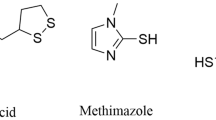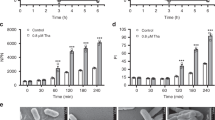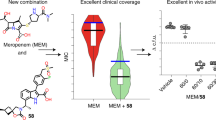Abstract
The superbug infection caused by metallo-β-lactamases (MβLs) carrying drug-resistant bacteria, specifically, New Delhi metallo-β-lactamase (NDM-1) has become an emerging threat. In an effort to develop novel inhibitors of NDM-1, thirteen thiosemicarbazones (1a-1m) were synthesized and assayed. The obtained molecules specifically inhibited NDM-1, with an IC50 in the range of 0.88–20.2 µM, and 1a and 1f were found to be the potent inhibitors (IC50 = 1.79 and 0.88 μM) using cefazolin as substrate. ITC and kinetic assays indicated that 1a irreversibly and non-competitively inhibited NDM-1 in vitro. Importantly, MIC assays revealed that these molecules by themselves can sterilize NDM-producing clinical isolates EC01 and EC08, exhibited 78-312-fold stronger activities than the cefazolin. MIC assays suggest that 1a (16 μg ml−1) has synergistic antimicrobial effect with ampicillin, cefazolin and meropenem on E. coli producing NDM-1, resulting in MICs of 4-32-, 4-32-, and 4-8-fold decrease, respectively. These studies indicate that the thiosemicarbazide is a valuable scaffold for the development of inhibitors of NDM-1 and NDM-1 carrying drug-resistant bacteria.
This is a preview of subscription content, access via your institution
Access options
Subscribe to this journal
Receive 12 print issues and online access
$259.00 per year
only $21.58 per issue
Buy this article
- Purchase on Springer Link
- Instant access to full article PDF
Prices may be subject to local taxes which are calculated during checkout



Similar content being viewed by others
References
Drawz SM, Bonomo RA. Three decades of β-lactamase inhibitors. Clin Microbiol Rev. 2010;23:160–201.
Andersson DI, Hughes D. Antibiotic resistance and its cost: is it possible to reverse resistance? Nat Rev Microbiol. 2010;8:260–71.
Spencer J, Walsh TR. A new approach to the inhibition of metallo-β-lactamases. ChemInform. 2006;37:1022–6.
Bush K. Past and present perspectives on β-lactamases. Antimicrob Agents Chemother. 2018;62:e01076–18.
Crowder MW, Spencer J, Vila AJ. Metallo-β-lactamases: novel weaponry for antibiotic resistance in bacteria. Acc Chem Res. 2006;39:721–8.
Papp-Wallace KM, Endimiani A, Taracila MA, Bonomo RA. Carbapenems: past, present, and future. Antimicrobial Agents Chemother. 2011;55:4943–6.
Cornaglia G, Giamarellou H, Rossolini GM. Metallo-β-lactamases: a last frontier for β-lactams? Lancet Infect Dis. 2011;11:381–93.
Docquier J-D, Mangani S. An update on β-lactamase inhibitor discovery and development. Drug Resistance Updates. 2018;36:13–29.
Xiang Y, Chang Y-N, Ge Y, Kang JS, Zhang Y-L, Liu X-L, et al. Azolylthioacetamides as a potent scaffold for the development of metallo-β-lactamase inhibitors. Bioorg Medicinal Chem Lett. 2017;27:5225–9.
González MM, Kosmopoulou M, Mojica MF, Castillo V, Hinchliffe P, Pettinati I, et al. Bisthiazolidines: A Substrate-Mimicking Scaffold as an Inhibitor of the NDM-1 Carbapenemase. ACS Infect Dis. 2015;1:544–54.
Ishii Y, Eto M, Mano Y, Tateda K, Yamaguchi K. In vitro potentiation of carbapenems with ME1071, a novel metallo-β-lactamase inhibitor, against metallo-β-lactamase- producing pseudomonas aeruginosa clinical isolates. Antimicrobial Agents Chemother. 2010;54:3625–9.
King AM, Reid-Yu SA, Wang W, King DT, De Pascale G, Strynadka NC, et al. Aspergillomarasmine A overcomes metallo-β-lactamase antibiotic resistance. Nature. 2014;510:503–6.
Proschak A, Kramer J, Proschak E, Wichelhaus TA. Bacterial zincophore [S,S]-ethylenediamine-N,N′-disuccinic acid is an effective inhibitor of MBLs. J Antimicrobial Chemother. 2017;73:425–30.
Cheng C, Xiang Y, Yang K-W, Zhang Y, Wang W-M, Su J-P, et al. A protein structure-guided covalent scaffold selectively targets the B1 and B2 subclass metallo-β-lactamases. Chem Commun. 2018;54:4802–5.
Everett M, Sprynski N, Coelho A, Castandet J, Bayet M, Bougnon J, et al. Discovery of a novel metallo-β-lactamase inhibitor that potentiates meropenem activity against carbapenem-resistant enterobacteriaceae. Antimicrobial Agents Chemother. 2018;62:e00074–18.
Rolain JM, Parola P, Cornaglia G. New Delhi metallo-beta-lactamase (NDM-1): towards a new pandemia? Clin Microbiol Infect. 2010;16:1699–701.
Zhu J, Sun L, Ding B, Yang Y, Xu X, Liu W, et al. Outbreak of NDM-1-producing Klebsiella pneumoniae ST76 and ST37 isolates in neonates. Eur J Clin Microbiol Infect Dis. 2016;35:611–8.
Azumah R, Dutta J, Somboro AM, Ramtahal M, Chonco L, Parboosing R, et al. In vitro evaluation of metal chelators as potential metallo-β-lactamase inhibitors. J Appl Microbiol. 2016;120:860–7.
Chen AY, Thomas PW, Stewart AC, Bergstrom A, Cheng Z, Miller C, et al. Dipicolinic acid derivatives as inhibitors of New Delhi metallo-β-lactamase-1. J Med Chem. 2017;60:7267–83.
Brem J, van Berkel SS, Zollman D, Lee SY, Gileadi O, McHugh PJ, et al. Structural basis of metallo-β-lactamase inhibition by captopril stereoisomers. Antimicrob Agents Chemother. 2016;60:142–50.
Wetli HA, Buckett PD, Wessling-Resnick M. Small-molecule screening identifies the selanazal drug ebselen as a potent inhibitor of DMT1-mediated iron uptake. Chem Biol. 2006;13:965–72.
Chiou J, Wan S, Chan K-F, So P-K, He D, Chan EW-C, et al. Ebselen as a potent covalent inhibitor of New Delhi metallo-β-lactamase (NDM-1). Chem Commun. 2015;51:9543–6.
Choudhury C, Priyakumar UD, Sastry GN. Dynamics based pharmacophore models for screening potential inhibitors of mycobacterial cyclopropane synthase. J Chem Inf modeling. 2015;55:848–60.
Knox JJ, Hotte SJ, Kollmannsberger C, Winquist E, Fisher B, Eisenhauer EA. Phase II study of Triapine® in patients with metastatic renal cell carcinoma: a trial of the National Cancer Institute of Canada Clinical Trials Group (NCIC IND.161). Investigational N. Drugs. 2007;25:471–7.
Spyrakis F, Santucci M, Maso L, Cross S, Gianquinto E, Sannio F, et al. Virtual screening identifies broad-spectrum β-lactamase inhibitors with activity on clinically relevant serine- and metallo-carbapenemases. Sci Rep. 2020;10:12763.
Draczkowski P, Tomaszuk A, Halczuk P, Strzemski M, Matosiuk D, Jozwiak K. Determination of affinity and efficacy of acetylcholinesterase inhibitors using isothermal titration calorimetry. Biochimica et Biophysica Acta (BBA) - Gen Subj. 2016;1860:967–74.
Zhang YJ, Wang WM, Oelschlaeger P. Real-time monitoring of NDM-1 activity in live bacterial cells by isothermal titration calorimetry: a new approach to measure inhibition of antibiotic-resistant bacteria. ACS Infect Dis. 2018;4:1671–8.
Morales S, Aceña JL, García Ruano JL, Cid MB. Sustainable synthesis of oximes, hydrazones, and thiosemicarbazones under mild organocatalyzed reaction conditions. J Org Chem. 2016;81:10016–22.
Sader HS, Flamm RK, Jones RN. Antimicrobial activity of daptomycin tested against Gram-positive pathogens collected in Europe, Latin America, and selected countries in the Asia-Pacific Region (2011). Diagnostic Microbiol Infect Dis. 2013;75:417–22.
Acknowledgements
This research was funded by the Grants (22077100 and 2019KW-068 to K.W.Y) from the National Natural Science Foundation of China and Shaanxi Province International Cooperation Project and grant (17JS007 to L.Z.) from the Shaanxi Education Commission, China.
Author information
Authors and Affiliations
Corresponding author
Ethics declarations
Conflict of interest
The authors declare no competing interests.
Additional information
Publisher’s note Springer Nature remains neutral with regard to jurisdictional claims in published maps and institutional affiliations.
Supplementary information
Rights and permissions
About this article
Cite this article
Ge, Y., Kang, PW., Li, JQ. et al. Thiosemicarbazones exhibit inhibitory efficacy against New Delhi metallo-β-lactamase-1 (NDM-1). J Antibiot 74, 574–579 (2021). https://doi.org/10.1038/s41429-021-00440-3
Received:
Revised:
Accepted:
Published:
Issue Date:
DOI: https://doi.org/10.1038/s41429-021-00440-3



